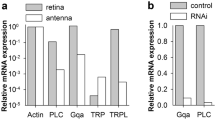Summary
A new class of Phycomyces behavioral mutants with enhanced tropic responses has been analyzed genetically to determine the number of genes involved and the nature of their expression. These hypertropic mutants carry pleiotropic nuclear mutations. Besides their effects on sensory behavior, they also affect morphology and meiotic processes. Behavioral analyses of heterokaryons containing hypertropic and wild-type nuclei in varying proportions show that the hypertropic mutations in strains L82, L84, L86, and L88 are strongly dominant. Conversely, the hypertropic mutations carried by the strains L83, L85, and L87 are strongly recessive. We performed recombination analyses between hypertropic mutants and mutants with diminished phototropism, affected in the seven genes madA to madG. We found no evidence of linkage between the hypertropic mutations and any of these mad mutations. From crosses, we isolated double mutants carrying hypertropic mutations together with madC (night blind) and madG (stiff) mutations. The behavioral phenotypes of the double mutants are intermediate between those of the parentals. Complementation analyses show that the three recessive hypertropic mutations affect the same gene, which we call madH. The expression of the recessive hypertropic allele becomes dominant in heterokaryons carrying madC and madH nuclei; the madC gene has been implicated separately with the photoreceptor at the input to the sensory pathway, while the madH gene is associated with the growth control output. This result suggests the physical interaction of both gene products, madH and madC, in a molecular complex for the photosensory transduction chain.
Similar content being viewed by others
References
Bergman K, Eslava AP, Cerdá-Olmedo E (1973) Mutants of Phycomyces with abnormal phototropism. Mol Gen Genet 123:1–16
Cerdá-Olmedo E (1977) Behavioral genetics of Phycomyces. Annu Rev Microbiol 31:535–547
Eslava AP, Alvarez MI, Lipson ED, Presti D, Kong K (1976) Recombination between mutants of Phycomyces with abnormal phototropism. Mol Gen Genet 147:235–241
Galland P (1983) Action spectra of photogeotropic equilibrium in Phycomyces wild type and three behavioral mutants. Photochem Photobiol, in press
Gauger W, Pelaez MI, Alvarez MI, Eslava AP (1980) Mating type heterokaryons in Phycomyces blakesleeanus. Exp Mycol 4:56–64
Heisenberg M, Cerdá-Olmedo E (1968) Segregation of heterokaryons in the asexual cycle of Phycomyces. Mol Gen Genet 102:187–195
Lipson ED, López-Díaz I, Pollock JA (1983) Mutants of Phycomyces with enhanced tropisms. Exp Mycol (submitted for publication)
Lipson ED, Terasaka DT, Silverstein PS (1980) Double mutants of Phycomyces with abnormal phototropism. Mol Gen Genet 179:155–162
López-Díaz I, Lipson E (1983) Meiotic dysgenesis associated with behavioral mutants of Phycomyces Curr Genet, in press
Medina JR, Cerdá-Olmedo E (1977) Allelic interaction in the photogeotropism of Phycomyces. Exp Mycol 1:286–292
Ootaki T (1973) A new method for heterokaryon formation in Phycomyces. Mol Gen Genet 121:49–56
Author information
Authors and Affiliations
Additional information
Communicated by G. Melchers
Rights and permissions
About this article
Cite this article
López-Díaz, I., Lipson, E.D. Genetic analysis of hypertropic mutants of Phycomyces . Mol Gen Genet 190, 318–325 (1983). https://doi.org/10.1007/BF00330658
Received:
Issue Date:
DOI: https://doi.org/10.1007/BF00330658




